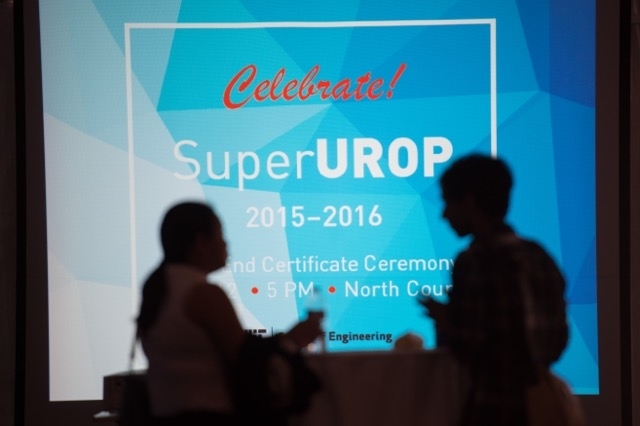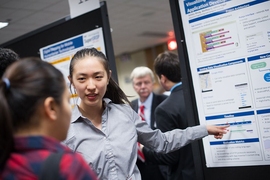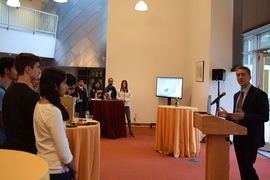The experiment worked. Four years ago, Anantha Chandrakasan had a hunch that MIT engineering undergraduates didn’t just want to “do” research — they wanted to immerse themselves in it. This year the experiment, the Advanced Undergraduate Research Opportunities Program (SuperUROP), has expanded across the School of Engineering.
SuperUROP lets students dive into independent lab work, model the commitment and depth of graduate work, and talk shop with faculty mentors and industry experts. The experience helps them discover, at heart, what it takes to do research and what it means to love it.
This is exactly the high-level engagement that Chandrakasan, the Vannevar Bush Professor of Electrical Engineering and head of the Department of Electrical Engineering and Computer Science (EECS), envisioned when he created the program in 2012. “We hope to create an interdisciplinary community of scholars,” he said at the time. “It is amazing to see the enthusiasm and innovative ideas that emerge as students interact with peers in their own and other areas.”
Here is how SuperUROP works in practice: Students are paired with a faculty member or MIT researcher, take a two-semester course on undergraduate research, and spend 10 hours (or more) in the lab. Often their year-long projects evolve into graduate theses, startup plans, or industry positions.
A sampling of what MIT’s SuperUROP students have been up to in 2015-16:
- Rising senior Julia Belk, an electrical science and engineering major, helped build small-scale electrical networks to enable people in developing countries to trade energy with neighbors. Belk learned to take ownership of a research project — the conception, theory, simulation, and experiment.
- Michael Burton, an aeronautics and astronautics undergraduate, created a model using Geometric Programming that will allow the exploration and evaluation of trade-offs in fixed-wing unpiloted aerial vehicle designs that will improve the overall design space of UAVs. “I worked at Boeing for military applications and believe research projects like this one can be total game changers for the aerospace industry.”
- Juan D. Castrillon ’16, an electrical engineering and computer science major, created an augmented reality system to model new objects using hand gestures. As a member of the Computational Fabrication Group at the Computer Science and Artificial Intelligence Laboratory (CSAIL), Castrillon witnessed firsthand the power of interdisciplinary research — and learned the results of such projects can be “new and amazing.”
- Justin Cheung ’16, a double major in physics and mechanical engineering and a minor in architecture, worked on a teleoperated humanoid robot designed for use in disaster relief. Immersed in the MIT Biomimetic Robotics Lab, he learned that being with people who love the same thing — in his case, robots — is a major draw. “I have been working in this lab for two years — and it has become another family for me,” he says.
- Josh Haimson ’16, a computer science and engineering major, developed a computational account for how humans can understand ungrammatical language. As a member of the Genesis Group at CSAIL led by Patrick Winston, the Ford Professor of Artificial Intelligence and Computer Science, Haimson learned the power of a great mentor. “I felt like I was taken under the wing of one of the preeminent minds in AI and given the opportunity to learn how he thinks about AI, academia, and life in a broader sense,” he says.
- Rising senior Tally Portnoi, an electrical engineering and computer science major, improved an imaging technique, MRSI, that provides clinicians with critical information about the chemical environment in the infant brain. “I saw that my lab work and that of others could actually lead to improved medical imaging and better care,” she says. “I learned how things actually get accomplished through research.”
- Rising senior Nalini Singh, an electrical engineering and computer science major, designed controllers for prostheses that operate better across different terrains as part of the Biomechatronics Group in the MIT Media Lab. Singh says she learned what it takes to be a good researcher: diligence and the perseverance to solve a problem no matter the obstacles.
- Jamila Smith-Dell, a chemical engineering major, built a device that intakes methanol vapor as fuel in order to generate electrical energy from chemical energy. Developments in such continual, one-dimensional thermopower wave fuel cells could lead to a whole new class of smaller and cheaper portable energy sources. “I had the opportunity to intern at Procter and Gamble and ExxonMobil during my summers, and I gained an understanding of both the consumer products industry and the energy industry.”
For Berj Chilingirian ’16, a double major in EECS and mathematics, and a member of the Cybersecurity Group at CSAIL, SuperUROP has enabled nothing short of a transformative intellectual and academic experience. “SuperUROP shaped my life — it has led me to pursue a PhD,” he said. “It was powerful.”








